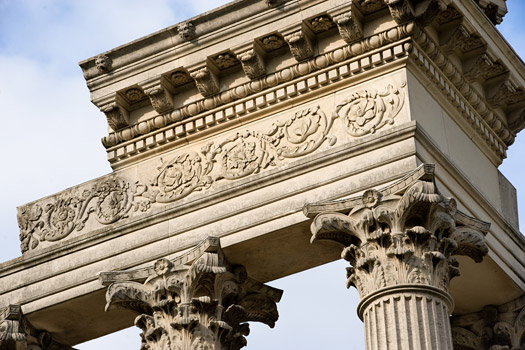
Römische Baukunst am Niederrhein
Mit einem monumentalen Hafentempel demonstrierten die Römer ihren Herrschaftsanspruch im linksrheinischen Gebiet.
© Foto Dietrich Hackenberg
Herrschaft zurück zur Auswahl
Roman architecture in the Lower Rhine
The temple complex of Colonia Ulpia Traiana would have been visible from quite a distance. It stood like a lighthouse on the left bank of the Lower Rhine near the mouth of the Lippe as the embodiment of Roman architecture marking the end of Germania inferior, which was the former Germanic region conquered in 57 BC by Gaius Julius Caesar. Standing a monumental 27 m, the temple was a prominent emblem of Roman culture and represented a piece of Rome in the provinces. In this building, the Romans provided numerous artistic influences in the frontiers of their empire, and introduced to the Lower Rhine an architectural vocabulary that was typical of the Mediterranean region.
The Colonia Ulpia Traiana – after Cologne and Trier, the third largest Roman town north of the Alps – was located near today's Xanten, at the intersection of two important transport axes. It was named after the Roman Emperor Kaiser Marcus Ulpius Traianus (53-117 AD), under whose rule the Imperium Romanum was to attain its greatest extent. He promoted this former legionary settlement to Colonia shortly before 100 AD.
The newly planned town was laid out in a grid pattern (Hippodamic system). The construction of public buildings such as the imposing town wall, temples, thermae and the Amphitheatre soon followed. At the intersection of the two new main streets the Forum was established as a political and commercial centre, and the Capitol was the most important temple for the gods.
Over 10,000 men, women, and children lived here; they traded as craftsmen and supplied the legionaries stationed there with their products, including those legionaries who had left military service and who sometimes continued to live there.
As citizens of a Colonia, the inhabitants of Ulpia Traiana possessed full Roman citizen rights, with all legal and tax privileges. The town was governed not by the military but by a civil administrative body, whose most important body was the town council which appointed the two mayors. Aedile were responsible for public security and for law enforcement in markets; and quaestors were in charge of financial matters.
After the failed attempt at conquering the Germanic regions east of the Rhine [[cf Herrschaft 50, Haltern und Oberaden]], the Romans concentrated on securing the western regions. Thus the Romans were able to consolidate their power, and integrate these regions into their empire, not only through military means but by building up a civil administrative apparatus. However, with the advance of the Franks east of the Rhine, Roman rule came to an end in the western regions too. The Colonia Ulpia Traiana was destroyed by the Franks in 275 AD. Some remains of the old Roman structures were used in building the town of Xanten.
Even the building material was new: the Hafentempel did not only look unusual, but also provided further innovation in the Lower Rhine region. The materials marble and limestone were largely unknown in this area. The stones had to be transported on the Lahn river at great expense from distant quarries in the Mediterranean. Thanks to the convenient geographical location of Ulpia Traiana dwhich was situated directly on the Rhine, the Romans were able to use boats for transporting the building materials. They used flat-bottomed barges, like the one found near Xanten-Wardt: this barge-type wooden boat dates back to 95 AD and with a load of 10 t, it had a load draught of just 50 cm.
Denkmale zum Impuls
Xanten - Römischer Hafentempel
Bei den Ausbauarbeiten des Archäologischen Parks Xanten stießen Archäologen 1977 ... weiter

